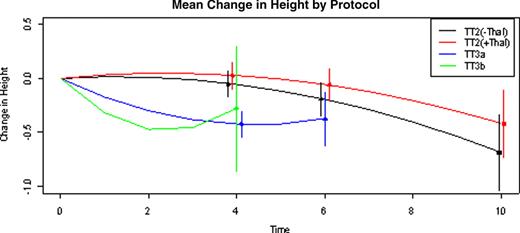Abstract
Abstract 1354
MM causes major morbidity as a consequence of bone destruction resulting both from diffuse osteopenia and discrete osteolytic lesions. While various imaging techniques have been useful to document MM bone disease (BD), such as X-rays, MRI and PET-CT scanning, MMBD invariably results in loss of height (LOH). Several interventions such as bisphosphonates and, more recently, novel agents can potentially slow and dexamethasone (DEX) enhance LOH.
TT2 and TT3 protocol patients with at least 3 height measurements, 1 at baseline and 1 at least one year after baseline constituted the eligibility criteria for this retrospective analysis of LOH. Some patients were excluded for data quality reasons. The metric for excluding these patients included change in height of at least ± 1 inch over a period less than or equal to 1 week, change in height of at least ± 2 inches over a period less than or equal to 1 month, and change in height of at least ± 3 inches over a period less than or equal to 6 months. This resulted in a sample of 309 patients from TT2, of whom 155 were treated on thalidomide arm (TT2+) while 154 were treated on the control arm (TT2-); of 204 patients receiving TT3, 142 were treated on TT3A (VTD maintenance) and 62 with TT3B (VRD maintenance). A linear mixed model was fit to the data, treating the height measurements as random subsamples in time. Individual quadratic fits were estimated for each protocol. Mean cumulative change in height was estimated at 4, 6 and 10 years from treatment.
The average rate of change in height for adults over 40 in the US is 1 cm (0.4 inches) every 10 years according to the MedlinePlus Medical Encyclopedia. Neither arm of TT2 had a mean cumulative change in height significantly different from the general population. The mean cumulative change in height for patients in the thalidomide arm of TT2 was slightly higher than the control arm (not statistically significant). The estimates for TT3 do suggest patients may decrease in height faster than patients in TT2. However, because of the high variability and relatively short follow-up time, the significance of results for TT3a and TT3b are questionable. This is especially true of TT3b.
Our data draw attention to a simple LOH characteristic that may be an excellent surrogate of overall bone health. At the time of the meeting, additional data will be presented on the impact of (1) dosing of bisphosphonate and cumulative maintenance therapy components, thalidomide, lenalidomide, DEX, and bortezomib; (2) time to and level of response (CR) and length of progression-free state; (3) kypho-/vertebro-plasty interventions; and (4) gene expression profiling (GEP)-defined risk and molecular subgroups.
No relevant conflicts of interest to declare.
Author notes
Asterisk with author names denotes non-ASH members.


This feature is available to Subscribers Only
Sign In or Create an Account Close Modal